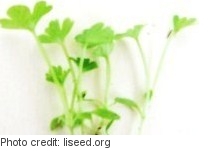Celery Microgreens: How to Grow Edible Celery Seedlings

To ensure a year-round supply of fresh, locally produced food, consider growing edible micro sized greens such as celery microgreens at home. Celery microgreens are not the easiest microgreens to grow, but with their delicious sharp flavor, they are definitely worth the time and effort. Celery microgreens boast a sharp flavor that is like a fresher version of mature celery, and as such, they are well suited for salads and other dishes that can benefit from extra sharpness. Harvested at about two inches tall, the delicate celery seedlings also make a great edible garnish to numerous dishes.
Note: Celery microgreens are not the same as celery sprouts; celery microgreens are grown in soil or a soil substitute, and are cut at the stem. Celery sprouts, on the other hand, are grown in water and eaten with the root, seed, stem and leaves.
Step-by-Step Instructions
The following paragraphs provide step-by-step instructions on how to grow celery micro greens indoors:- Buy celery seeds labeled "for sprouting" or "for use as microgreens" from a reputable organic supplier. Soak the seeds in lukewarm water for 24 hours. Celery microgreens are not the easiest microgreens to grow, but pre-soaking the seeds will greatly increase your chances of growing a succesful celery microgreen crop.
- Fill a seed-starting tray or another container with fine-textured potting mix and moisten the mix. Pat down the soil gently to be sure there are no air pockets. Scatter the celery seeds evenly on top of the potting mix and gently press them into the soil.
- After sowing your celery seeds, place the container near a bright window or another sunny location in order to ensure the young celery seedlings get plenty of sun. Invest in a grow light if you don't have a sunny location for your indoor celery microgreen garden.
- Watering your celery seeds, and later on seedlings, is an important step in the celery microgreen growing process. Giving your celery microgreens too much water may cause your seedlings to become water-logged while a lack of water will cause them to dry out. A good way to ensure your celery seedlings are getting enough, but not too much, water is to use a spray bottle for watering. You should use it to mist the soil evenly and thoroughly. Once the seedlings are stronger, you can also use a small can for watering.
- Be patient and give your celery microgreens enough time to grow. Compared to many other micrgreens, celery germinates and grows relatively slowly. Once your celery microgreens are a few inches tall, they are ready to harvest. Celery microgreens are harvested by snipping these delicate greens just above the soil. Micro-celery is typically harvested just before serving, which helps protect its nutritional properties.
- Celery microgreens boast a sharp flavor that is like a fresher version of mature celery. Celery microgreens are ideal for salads and other dishes that can benefit from extra sharpness. Young and attractive celery seedlings also make a great edible garnish to numerous dishes.

